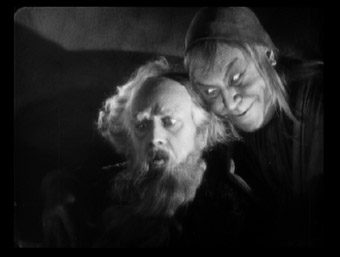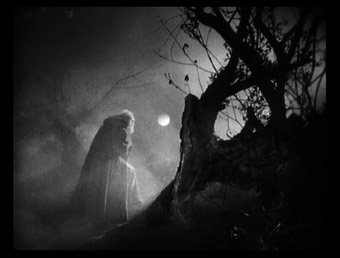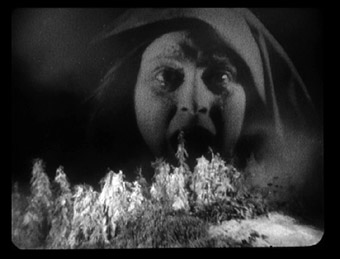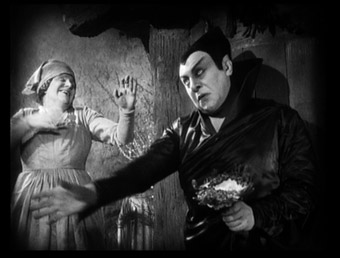|
The
story of Faust, from its origins in German folk tales through to
its artistic realisation in the works of Christopher
Marlowe, Goethe and Charles Gounod and its later interpretation
in a variety of media, remains the most oft-retold and influential
works in German literature. To this day, it is regarded as
potent dramatic stuff, and despite its religious trappings, it
carries a message about the destructive effects of self-centred
desire at the expense of all else that reach beyond the
theological and right into the heart of modern western
existence.
The
phenomenal popularity and influence of the tale can be
measured in the sheer volume of adaptations over the years. These include written fiction,
plays, operas, stage musicals, rock songs, classical
music, comic books, manga animes, video games (Wikipedia lists 15 games that include characters or plot
elements from the story) and, of course, movies. If you
want a further barometer of its influence here, there were
at least seven film versions completed before 1920. In the
years that followed, the story has been reworked as comedy
(Bedazzled, twice), dark thriller (Angel
Heart), surrealist animation (by Jan Svankmajer in
1994), and even comedy-musical-horror (Brian De Palma's The Phantom of the Paradise), and that's
not counting the numerous straight adaptations of the tale,
right up to Brian Yuzna's 2001 Faust: Love of the
Damned. You'd have to have led a very sheltered
existence to have not come across the story in one form
or another.

In
the realms of silent cinema, which is to say cinema itself,
German director F.W. Murnau is a true artistic giant. You want proof?
See his first American film, Sunrise,
once described by the influential Cahiers du Cinéma as "The single greatest masterwork in the history of
the cinema" and by none other than John Ford as the very future of
the medium itself. And then there's Nosferatu,
eine symphonie des grauens, the first adaptation
of Bram Stoker's genre-defining novel Dracula, and
still for my money the greatest of all vampire movies.
As it was with Nosferatu, so it is with
Faust. Murnau may not be the only one telling
the story, but once again he set the benchmark, and few
that followed have come close to matching the visual poetry
of his interpretation.
The
film is based largely on part 1 of Goethe's play, with influences
from Marlowe and a few significant inventions by Murnau
himself. In a world beyond our own, Mephistopheles wagers
the Archangel Gabriel that he can completely corrupt the
elderly professor Faust – a good man who has dedicated his
life to science and healing the sick – and gain control of
his soul. The prize if he is successful? The earth itself.
Now I have to say that although the angel is acting out
of true faith that goodness will always triumph over evil
in any man, this is a seriously bloody reckless bet to make. But
I digress. Mephistopheles knows just how to entrap the professor
and unleashes a great plague upon the people of his town, prompting its citizens to turn to the learned Faust for help. But his treatments prove
ineffective, and in desperation he acts on information
found in a religious tome and summons the demon Mephisto,
who gives him the power to cure the villagers, but when
they realise just where these new skills came from they
immediately turn against the well-intentioned professor.
In despair he attempts suicide but is stopped by Mephisto,
who transforms him from an old man to the virile youth he
once was and tempts him with the (half-naked) figure of
the Duchess of Parma, the most beautiful woman in all of
Italy. A superbly realised flight across the landscape later,
they drop in on the Duchess's wedding feast – Faust woos
the girl while Mephisto sorts out her would-be husband.
But at the very moment the young Faust is about to have
his way with the Duchess, the time runs out on his pact (visualised
in a rapid track towards an hour glass, a shot that is now
a filmmaking standard). He is now faced with a choice – return to the helpless old man that he was or stay as he is
and deliver his soul into Mephisto's clutches forever.

Even
those unfamiliar with the story (there must be some) will
have a pretty good idea which option the now young, sex-hungry
Faust selects. He has his youth, he has Mephisto to act
on his every command, and soon he hungers for the town that
long ago was home. Transported there by Mephisto, in no
time at all he is chasing after the beautiful and virginal
Gretchen, who, with a little demonic assistance, falls head-over-heels
in love with this handsome young visitor. Things for young
Faust could not be more blissful, but he
has become intoxicated both by his new life and the power
he is able to wield through Mephisto, and seems to have completely
forgotten that he is dealing not with a benevolent genie, but
a most malevolent demon.
This
almost operatic storytelling lends itself well to the grand
gestures of silent cinema, but it takes a filmmaker of Murnau's
unique vision to shake off the theatrical elements
and realise the story in such vibrantly cinematic terms.
When dealing with great silent cinema you inevitably find
that some of your critical tools have been reversed – whereas
in a modern film you might find yourself ticking off the borrowings, here you're more likely to be noting the scenes
and images that were later to be recycled by
others. The story may be old but the film itself is a true
original, and the imagery and cinematic technique on display here
are the products of the filmmakers' collective imagination
rather than a distillation of their own earlier viewing
experiences. And
what imagination. There's barely a shot in the film that
does not prompt you to draw breath at the exquisite perfection
of its composition, and there are a fair few that will have you gawping
in disbelief. But this is never purely decorative and is always crucial to Murnau's very visual storytelling
technique. When, for example, Mephistopheles towers above
the town, slowly spreading his wings to block out the sun
and unleashing a dark cloud of plague, this is not just a
gobsmakingly imposing composition, it vividly suggests his
awesome power and sinister intent. I would imagine that
back in 1926 this was a genuinely terrifying image – even
today, after many years of exposure to horror literature
and movies, it gave me the serious creeps.
Superimposition, later to prove such a vibrant technique
in Sunrise, is brilliantly used here, placing
rings of fire around Faust, and the horsemen of the apocalypse
(all three of them – they appear to be a man short) above
his head as he summons Mephisto, transforming a memory into a
vivid hallucination for Gretchen, and sending a scream flying
across the landscape to distant ears. The lighting is consistently gorgeous and always expressive, Murnau's use of light and shadow drawing
on his theatrical experience with Max Reinhardt and having
subtextual as well as artistic purpose, while the sometimes
expressionistic set design (the view of the town from Gretchen's
house can't help but recall The Cabinet of Dr. Caligari) suggests an instability to Faust's new reality and prefigures
the nightmare turn the narrative is soon to take.

The
grand guignol and dark drama of the opening scenes lightens
considerably in tone when we arrive at Heimat (literally
"home") and Faust begins his romantic pursuit
of Gretchen. Even Mephisto is transformed from his unsettling
first appearance into the film's comic relief, mirroring Faust's
wooing of Gretchen by pretending to flirt with Martha, the
village Wiccan, which initially allows him to cop a feel
but later has him running from her amorous advances. Cheery
and engaging though he is at this point, Mephisto never forgets his malevolent purpose for
a moment, and at the very instant
Faust gets his girl, Mephisto is down the pub setting him
up for an almighty fall.
It
is here that the film undergoes a tonal shift and
delivers a series of emotional body blows that really
register. Faust almost drops out of the story for a while and
it's Gretchen who gets to suffer (on the commentary
it is wittily suggested that the story takes a Lars von Trier
turn). To start going into detail about where the plot
goes from here would be inappropriate for newcomers – safe
to say it's uncompromising and genuinely affecting
stuff, and leads to a mother of an ending that has been
very nicely tweaked from Goethe's original.
Religion,
inevitably, is at the core of the film, the narrative itself
revolving around a wager made between heaven and hell, and
Mephisto has come to earth to corrupt and destroy,
just as we have always been warned. God is good and the
devil is very, very bad, and putting your trust in the latter
is really asking for trouble. This is no big surprise for a film
made in Europe in 1926 – what is surprising is
that those who live by religion are shown to be judgemental,
intolerant, easily led and generally unpleasant (I was really
in sympathy with Mephisto when, on hearing local parishioners
singing their praises to God, he winces in pain and jams his
fingers in his ears). When the plague is unleashed, they would rather die of
it than be treated by a man who may, perhaps, have
consorted with demons (they decide this because he shies
away from a cross – this was later to become the mark of
a vampire, but interestingly not in Murnau's Nosferatu).
Later, the good people of Heimat behave appallingly towards
Gretchen, culminating in a false accusation for a tragedy
that their own self-righteousness heartlessness is directly
responsible for bringing about.
Faust
is up there with the giants of silent cinema, a magnificent
and truly cinematic realisation of one of the most celebrated
of literary dramas, one genuinely innovative and forward-looking
in its film technique. Its astonishing visual inventiveness
is made all the more impressive when you consider that its
often complex imagery was achieved not at some high priced
effects house, but on set and in-camera by Murnau and his
team (cinematographer Carl Hoffman deserves a special mention
here), and yet I'd take it over even the most perfectly
realised CGI any day of the week. Any way you look at it,
Faust is a fabulous achievement and
that rarest of cinematic beasts, a fine entertainment that
comfortably wears the badge of great art.
Included
in Masters of Cinema's 2-disc DVD set are two versions of
Faust, identified here as the International
and Domestic versions. Now this is no case of a simple recut
for the home market – Faust was filmed
simultaneously with two cameras to produce two edits, with the best takes used for the domestic print
and the lesser ones for the international release. Structurally
the two films are virtually identical – the differences
are in the framing of specific shots and the editing pace
and, occasionally, shot order. It actually makes little
difference to your overall enjoyment of the film, but does
effect individual scenes in subtle (and occasionally quite
dramatic) ways. The general opinion, and I am not going
to argue with this, is that the domestic cut is superior.
And there's another thing...

OK,
the film was made in 1926 and allowances have to be made
for image quality and the detrimental effects of age and
imperfect storage. With that in mind, the quality of the
print on the international version is pretty damned good – black levels are solid and detail is very reasonable for
a film of this vintage. Inevitably there are dust spots,
scratches and even the occasional bit of damage, but on
the whole the film is in very good shape and the cleanliness
of the print is is remarkable.
But watch
the international version first and you'll be especially
impressed with the domestic print. Only recently discovered
and in astonishingly good condition, this version was reconstructed
by Luciano Berriatúa for Filmoteca Española
from nitrate dupe negatives printed by UFA in 1926 and a
number of other international sources. Detail and shadow detail in particular is noticeably superior to the
international print, something usefully highlighted in the
comparison featurette (see below). The picture is framed 1.33:1 within a small black border,
presumably to avoid information loss on CRT TV overscan.
There
are two music tracks available for the domestic print, a full
orchestral score composed by Timothy Brock and a new harp
score composed and played by Stan Ambrose. Sonically, both
sound very good, the Ambrose score in particular, and which
one works best is very much a matter of personal preference.
My own choice is very much the Timothy Brock score, a handsome
piece that perfectly matches the film's dramatic tone. I
have to admit to not being particularly fond of the harp
as a solo instrument, a prejudice that inevitably influences my choice,
but I would also argue that the Stan Ambrose score serves
the film less well, rarely underscoring or emphasising the
mood or dramatic thrust of individual scenes. Indeed, the
tone and style of the piece varies little throughout, which
can't help but make the score sound more like a decorative
extra than integral to the film. Like I said, a matter of
taste. The International version has only the Brock score.
Works for me.
A
brief note on the DVD cover art, which I presume is a reproduction
of original film artwork and looks splendid, but has the
title written in old-style gothic text, with an 's' that
looks more like a modern 'r'. Not a problem if you know
what you're looking for, but this may be an issue for the
potentially casual buyer. On seeing the DVD box, my girlfriend
picked it up, looked at it with interest and then asked,
"What's it about?" "Well, the story of Faust
is…" I began, to which she replied, "Oh...FAUST!
I didn't realise!"
The
extra features are spread over the two discs. Although not
great in number, their quality more than makes up for this.

The
prime extra is on disc 1 (the domestic print) in the form
of a Commentary by critic and
journalist David Ehrenstein and the US correspondent for
Cahiers du cinéma Bill Krohn, the pair responsible
for the highly informative and entertaining commentary on
The Savage
Innocents. On the evidence of that film and
their contribution here, Masters of Cinema would do well
to keep these guys sweet. They clearly love the film (no
arguments here) and really know their cinema history, citing
a whole string of works influenced by Murnau and Faust in
particular, including Fantasia (which they
describe amusingly as "a much lesser work"), The
Devils, Citizen Kane, The
Ten Commandments, The Wizard of Oz
and the works of James Whale and Terry Gilliam, to name
but a few. It's a consistently fascinating and enjoyable
listen, and really does add to your enjoyment and appreciation
of the film itself.
On
disc two there are two very interesting featurettes.
A
Comparison of the Domestic and Export Releases
(26:47) very usefully and clearly highlights some key differences
between the two versions, including the framing of shots,
the editing and, perhaps most startling in the pub scene,
the very visible difference in clarity and detail.
Tony
Rayns on Faust (37:51) is a gunsight-framed,
black-and-white interview with one of MoC's more regular
collaborators, though usually on their releases of Japanese
films, which is Rayns' real area of expertise. There's not
much to look at, but what is said is of considerable interest,
as Rayns provides background on the evolution of the film,
the influence of Max Reinhardt, information on Murnau himself,
and even the reasons for shooting two versions at the same
time (whether you buy into the cost saving suggestion when
UPA were apparently making duplicate negatives anyway, from
which this restoration was largely drawn, is another matter).
Finally,
we have the usual Masters of Cinema Booklet,
which contains a detailed essay on the film by Peter Spooner,
and a shorter one by R. Dixon Smith on the multiple versions
of the film. Not as densely packed as some of their booklets,
this is nonetheless a typically interesting read.
Old
story, simple moral, religious overtones, but oh, what a
movie this is. Many regard the tale itself and a piously
simplistic one, and they may have a point, but in an age
where the pursuit of wealth and its material trappings with
no thought of the consequence to others is regarded by many
as a good thing, the underlying message still has validity.
But as Tony Rayns points out, what make this great cinema
is what Murnau and his team do with it, creating a film
that prompts us to marvel at the possibilities of the medium
and the skill and imagination of its pioneers.
Masters
of Cinema have done it again with this excellent 2-disc
release, featuring both versions of the film, two scores,
a first rate commentary and two very informative featurettes.
If silent cinema is your thing (and if you are a true film
fan then it should be), then you are in for a treat.
|